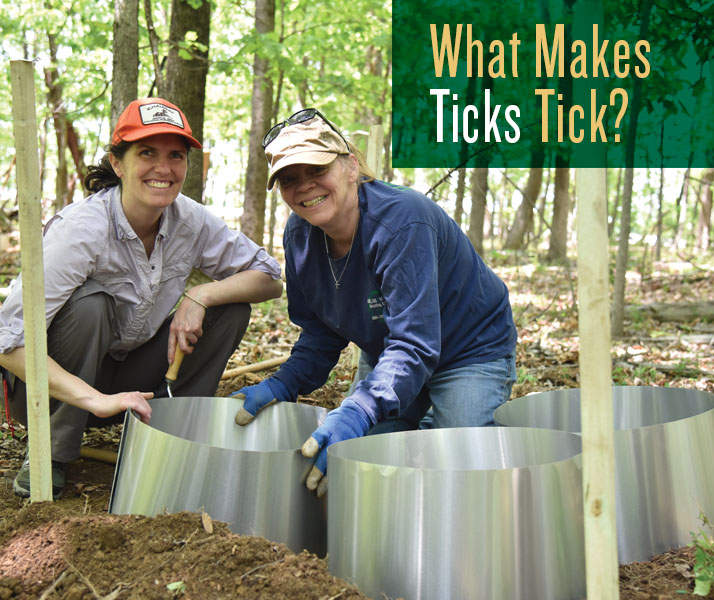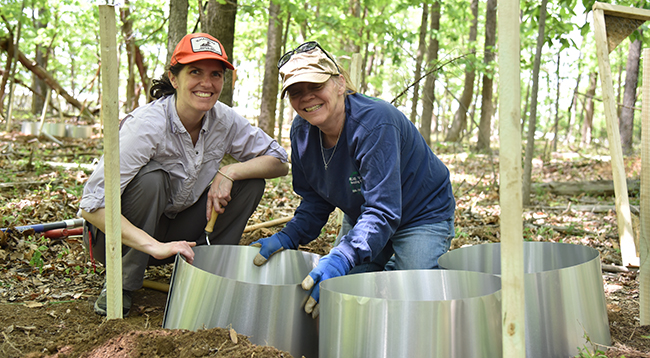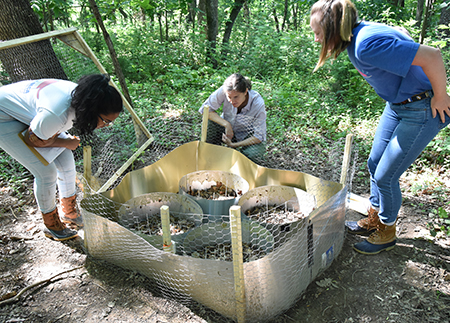
What Makes Ticks Tick?
Hollins researchers partnered this summer with Old Dominion University and the University of Richmond to better understand these parasites and how they spread Lyme disease.
By Jeff Hodges M.A.L.S. ’11
On a warm and sunny June morning, Assistant Professor of Biology and Environmental Studies/Environmental Science Elizabeth “Liz” Gleim ’06 and two student researchers are kneeling, motionless and silent, in a forest near the Hollins Riding Center. They are staring intently into what appears at first glance to be containers of dull and lifeless leaves. The chance they’ll get to see anything of significance is remote; still, the three scientists dutifully scan these leaf litters over and over in an effort to learn more about the spread of a malady the Centers for Disease Control estimates will affect 300,000 Americans each year.

Liz Gleim ’06, who teaches in the biology department, and Cheryl Taylor, biology lab technician, setting up the “tick arenas” in the woods near the riding center. Photo by Sharon Meador.
In the fight to stop Lyme disease, one question has baffled investigators: Why is the disease so prevalent in the northeastern United States, but in the Southeast, relatively few cases have been reported? The trend persists even though the blacklegged ticks (or deer ticks) that transmit Lyme through their bites can be found throughout the eastern U.S.
Gleim, a tick biologist, says one hypothesis has gained traction: the possibility that “the northern and southern populations of the blacklegged tick are genetically distinct, and that difference manifests itself in terms of how ticks quest for a host. A questing tick crawls up on the tips of vegetation and hopes a human or animal host is going to brush up against them and they can hop a ride.” She adds that northern ticks have been found to be far more aggressive when questing and thus more likely to latch on to people than southern ticks. (Interestingly, the Roanoke area is a major hot spot for Lyme disease. Researchers theorize that northern ticks are making their way down through the mountains to the southern region.)
Even in Virginia, questing behaviors vary between ticks from the coastal, central, and southwestern parts of the state. This summer, Gleim and a student researcher collaborated with scientists from Old Dominion University and the University of Richmond to learn why.
“Ticks along the coast are generally not as aggressive as those here in the Roanoke area. So we collected ticks locally, around Richmond, and along the Virginia seaboard, sort of an east-west gradient, in the hope that we could get populations that may be showing different questing behaviors,” Gleim explains. “Is their behavior actually controlled by genes, or is it prompted by three distinctive climates?”
Gleim and her fellow researchers took the ticks they gathered and placed them in “tick arenas” situated in mature hardwood forest areas, the preferred habitat of blacklegged ticks. At Hollins, the tick arenas were located in the woods near the northeastern part of campus.
“It’s great that we could take advantage of our conveniently located natural forests,” Gleim states. “We’re lucky because the researchers in Richmond and on the coast had to use public lands. They had to go through the process of working with state and public officials to secure permission.”
Faculty from the biology and environmental studies/environmental science programs at Hollins helped Gleim construct the tick arenas and ensure the ticks in the study stayed in place while those living in the surrounding forest were kept out. “We put sterilized leaf litter into the containers to be certain we weren’t inadvertently picking up ticks that weren’t part of our research. Installing metal flashing and chicken wire not only helped keep ticks out but also prevented wildlife from entering the arenas. The last zone of defense was a sticky material that we used to coat the inside of each arena. Any ticks that tried to leave or enter the arenas got stuck.”

Shravani Chitineni ’21 (left) and Hailey Bivens, a recent graduate of the University of Richmond (right), assisted Gleim, spending hours each week during the summer observing the insects’ questing behaviors. Photo by Sharon Meador.
The campus site was maintained through early July to coincide with when blacklegged ticks are naturally active. Gleim was assisted by Shravani Chitineni ’21, who is leaning toward pursuing a biology major and mathematics minor at Hollins, and Hailey Bivens, a recent graduate of the University of Richmond and a Roanoke resident. They visited the tick arenas twice a day, twice a week, to spot the ticks and see what questing behaviors they were exhibiting.
“I wanted to get a feel for working outside. Even seeing a little bit of movement was very exciting,” Chitineni recalls. “This has piqued my interest in doing more fieldwork in the future.”
Both Chitineni and Bivens say the experience helped them develop keen observation skills and considerable perseverance. With this work, Bivens says, “you have to have a lot of patience to get results.” For extended periods of time, “you’re not seeing what you want, you’re not seeing a whole lot of anything.”
“It’s always an eye-opening experience the first time we have students coming and doing any type of research,” Gleim adds. “Fieldwork is really hard.”
After the outdoor initiatives at Hollins and other parts of Virginia concluded in July, the tick research transitioned into its second phase, a molecular component conducted at the University of Richmond and elsewhere that will wrap up early this fall.
“If all goes well,” Gleim says, “we plan to publish the results in a yet-to-be-determined scientific journal, and our students will be included as co-authors.”
Jeff Hodges is Hollins’ director of public relations.
